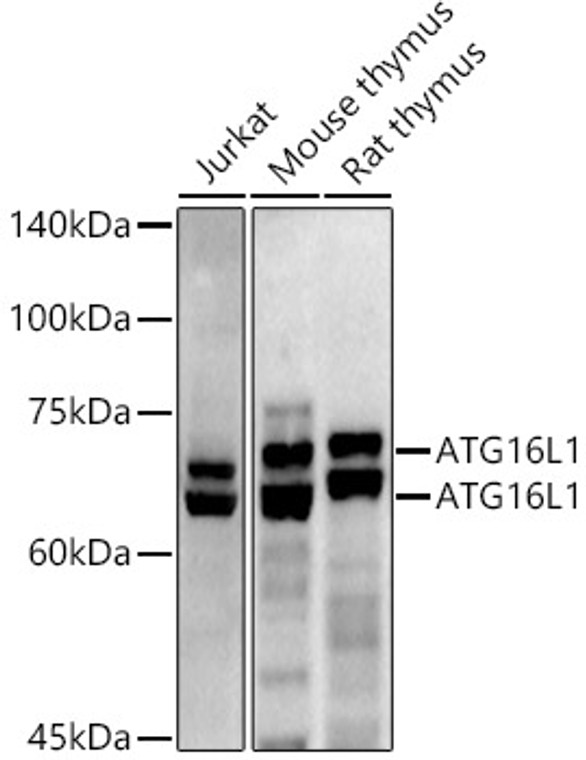| Host: |
Rabbit |
| Applications: |
WB |
| Reactivity: |
Human/Mouse/Rat |
| Note: |
STRICTLY FOR FURTHER SCIENTIFIC RESEARCH USE ONLY (RUO). MUST NOT TO BE USED IN DIAGNOSTIC OR THERAPEUTIC APPLICATIONS. |
| Short Description: |
Rabbit polyclonal antibody anti-Autophagy-Related Protein 16-1 (60-300) is suitable for use in Western Blot research applications. |
| Clonality: |
Polyclonal |
| Conjugation: |
Unconjugated |
| Isotype: |
IgG |
| Formulation: |
PBS with 0.05% Proclin300, 50% Glycerol, pH7.3. |
| Purification: |
Affinity purification |
| Dilution Range: |
WB 1:100-1:500 |
| Storage Instruction: |
Store at-20°C for up to 1 year from the date of receipt, and avoid repeat freeze-thaw cycles. |
| Gene Symbol: |
ATG16L1 |
| Gene ID: |
55054 |
| Uniprot ID: |
A16L1_HUMAN |
| Immunogen Region: |
60-300 |
| Immunogen: |
Recombinant fusion protein containing a sequence corresponding to amino acids 60-300 of human ATG16L1 (NP_110430.5). |
| Immunogen Sequence: |
KHDVPNRHEISPGHDGTWND NQLQEMAQLRIKHQEELTEL HKKRGELAQLVIDLNNQMQR KDREMQMNEAKIAECLQTIS DLETECLDLRTKLCDLERAN QTLKDEYDALQITFTALEGK LRKTTEENQELVTRWMAEKA QEANRLNAENEKDSRRRQAR LQKELAEAAKEPLPVEQDDD IEVIVDETSDHTEETSPVRA ISRAATKRLSQPAGGLLDSI TNIFGRRSVSSFPVPQDNV |
| Post Translational Modifications | Proteolytic cleavage by activated CASP3 leads to degradation and may regulate autophagy upon cellular stress and apoptotic stimuli. Phosphorylation at Ser-139 promotes association with the ATG12-ATG5 conjugate to form the ATG12-ATG5-ATG16L1 complex. |
| Function | Plays an essential role in both canonical and non-canonical autophagy: interacts with ATG12-ATG5 to mediate the lipidation to ATG8 family proteins (MAP1LC3A, MAP1LC3B, MAP1LC3C, GABARAPL1, GABARAPL2 and GABARAP). Acts as a molecular hub, coordinating autophagy pathways via distinct domains that support either canonical or non-canonical signaling. During canonical autophagy, interacts with ATG12-ATG5 to mediate the conjugation of phosphatidylethanolamine (PE) to ATG8 proteins, to produce a membrane-bound activated form of ATG8. Thereby, controls the elongation of the nascent autophagosomal membrane. Also involved in non-canonical autophagy, a parallel pathway involving conjugation of ATG8 proteins to single membranes at endolysosomal compartments, probably by catalyzing conjugation of phosphatidylserine (PS) to ATG8. Non-canonical autophagy plays a key role in epithelial cells to limit lethal infection by influenza A (IAV) virus. Regulates mitochondrial antiviral signaling (MAVS)-dependent type I interferon (IFN-I) production. Negatively regulates NOD1- and NOD2-driven inflammatory cytokine response. Instead, promotes an autophagy-dependent antibacterial pathway together with NOD1 or NOD2. Plays a role in regulating morphology and function of Paneth cell. |
| Protein Name | Autophagy-Related Protein 16-1Apg16-Like 1 |
| Database Links | Reactome: R-HSA-1632852 |
| Cellular Localisation | CytoplasmPreautophagosomal Structure MembranePeripheral Membrane ProteinEndosome MembraneLysosome MembraneRecruited To Omegasomes Membranes By Wipi2Omegasomes Are Endoplasmic Reticulum Connected Strutures At The Origin Of Preautophagosomal StructuresLocalized To Preautophagosomal Structure (Pas) Where It Is Involved In The Membrane Targeting Of Atg5Localizes Also To Discrete Punctae Along The Ciliary AxonemeUpon Activation Of Non-Canonical AutophagyRecruited To Single-Membrane Endolysosomal Compartments |
| Alternative Antibody Names | Anti-Autophagy-Related Protein 16-1 antibodyAnti-Apg16-Like 1 antibodyAnti-ATG16L1 antibodyAnti-APG16L antibodyAnti-UNQ9393 antibodyAnti-PRO34307 antibody |
Information sourced from Uniprot.org
12 months for antibodies. 6 months for ELISA Kits. Please see website T&Cs for further guidance






